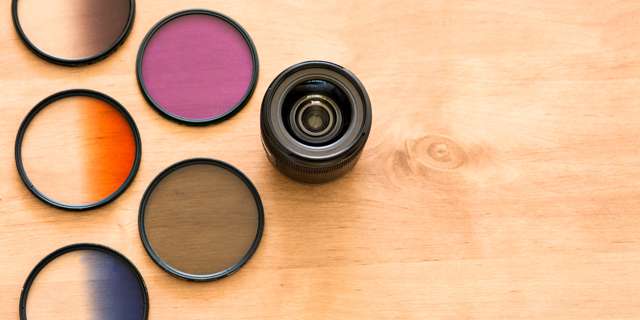
To help photographers and videographers realize their vision, lens filters must be consistent in color and free from contaminants. Image Source: Shutterstock user Layue
Colored lens filters are essential tools for photographers and videographers. These accessories improve the quality of their images and help them achieve the aesthetic they are seeking to create, expanding both technical and creative boundaries. However, this can only happen when the color of the lens is consistent and the product is free of contaminants such as dust or other types of flaws in the glass. If the lens is too hazy or the color is too light or dark, it could compromise the quality of the final image. To prevent this, manufacturers of colored lenses must rigorously test their products for color consistency and clarity throughout the production process. When you perform color quality control tests throughout your manufacturing process, you’ll ensure the integrity of your products, refine your production processes, and help your customers realize their artistic visions.
The Importance of Color Consistency and Clarity in Lens Filters
Different lens filters have very specific uses in photography and videography and are sought out to create unique effects that are not possible with conventional lenses. But if the filter is off in color by even a few subtle shades, it could significantly impact the image’s appearance. This is why color consistency is critical for lens filter manufacturers to achieve.
For example, UV filters for cameras are typically clear, but filters that contain a heavier coating of UV filtration will start to look amber in color.1 In fact, if you want your product to filter out as much UV light as possible, your filter should appear fairly dark. If your filter appears almost colorless, however, it may be a sign that you haven’t coated the filter properly and the level of UV protection may be diminished. This can significantly impact the functionality of the filter and create unwanted—and unappealing—color shifts. For example, on a sunny day when the camera is exposed to a great deal of UV light, a blue haze may appear in the final image if UV light is not properly filtered out. Similarly, skylight filters are typically pink in color because they counterbalance the blue bias that film stock typically has. However, this requires a delicate balance; if your filters are too pink, they will make all of the blue tones in the image disappear, whereas if the filters aren’t pink enough, they won’t effectively counterbalance the blue tones in the film. This is why it’s important to get the color just right on your lens filters.
Unfortunately, achieving the right lens color can be difficult, as you must dye the lacquer the same color from batch to batch and you also apply this lacquer in a consistent layer to create the colored film. If you fail to dye the lacquer properly or you apply the lacquer in uneven layers, it could cause the color of the lens filter to appear inconsistent. Additionally, haze and contaminants in the glass can impact the appearance and functionality of the product. For instance, if you use thick glass, you’re much more likely to have air bubbles or other flaws in the product that will show up on film. If you use colored polarizing filters (made from plastic) that you place between two layers of glass, contaminants may come between the glass and the colored film, resulting in a permanent flaw. Other factors like improper formulation and even the oils from your hands can make the lens filter appear hazy. This cloudiness, regardless of the source, will have an effect on the final image; the unwanted particles in the lens will scatter the light when it hits the lens’ front element, and this could cause a stray lighting effect or result in a blurry image.2
To ensure that your lens is manufactured correctly, you should test your materials for color and clarity throughout the manufacturing process. Using a spectrophotometer, you can ensure that the color of your lenses is consistent from one batch to the next and that your glass is free of any potential contaminants.




